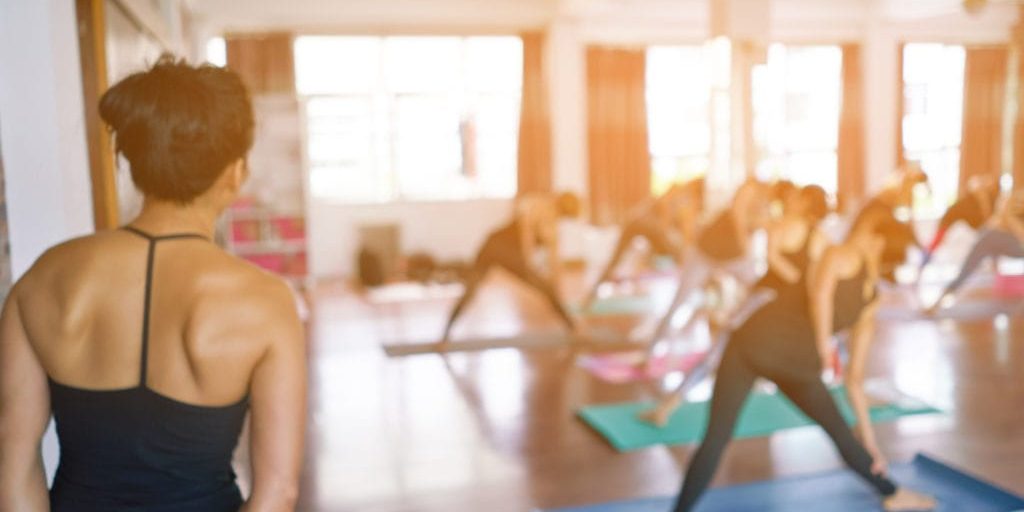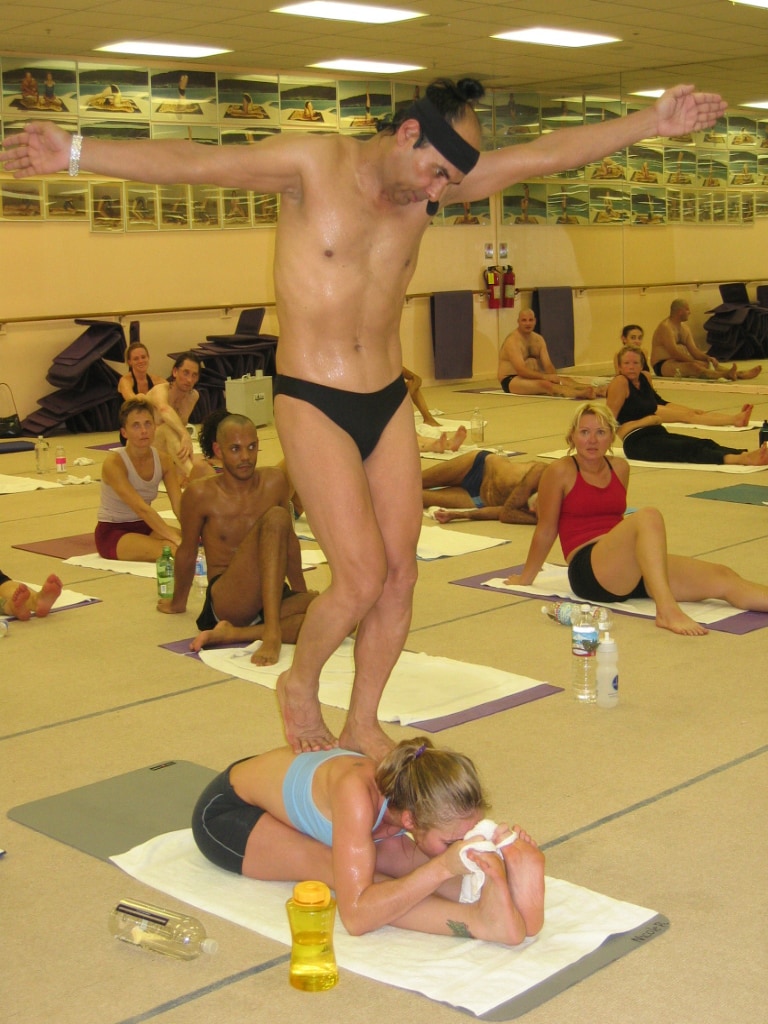Bikram Yoga
Whether you have a consistent yoga practice, or you’ve never set foot in a studio before, there’s a chance you’ve heard of Bikram Yoga. Reaching the Western world in the early 1970s, Bikram Yoga became known for its heat and intensity. A life changing sequence, boasting many celebrity supporters, the popularity of Bikram Yoga reached a peak of some 1,650 studios in 40 countries.
It was yoga, but, hot?! Why? Is the heat just a gimmick or is there something in this practice? And what about the guy that ‘invented’ it? What happened there?

What is Bikram Yoga?
Lets start with the basics. To break it down, Bikram Yoga is a type of yoga comprised of static Hatha asanas (postures). 26 postures and 2 breathing exercises to be exact. Repeated twice in a room heated to 40c and above. The sequence is always the same and should be practiced in front of a mirror. The first half of the sequence consists of standing and balancing postures. The floor series follows and includes several spine strengthening postures.
Often referred to as ‘The Original’ hot yoga, your standard Bikram class will make you sweat from head to toe. The class is 90 minutes long and you are not encouraged to leave the room during this time.
The class can only be led by a qualified Bikram Yoga teacher, who stands at the front of the room, usually on a podium or step. The teacher will lead the class by speaking a scripted dialogue, written specifically (by Bikram Choudhury) to guide students into the postures correctly.
Why the heat?
There are physical benefits to stretching in a heated room. Your muscles are warm and you are less likely to experience injury. This also benefits your practice, allowing you to reach deeper into some postures. The sweat from your body also benefits your skin as you flush out bacteria from the surface.
Aside from the physical benefits, there is a lot to be said for practicing yoga in a challenging environment. Your body is perfectly capable of handling the heat, but your mind will tell you all sorts of things to get out of that room. It is in this situation that you really begin to learn the power your breath can have. When nothing else can comfort you, coming back to your breath and harnessing the ability to calm yourself down, is one of the best skills you can acquire in life.

Is Bikram Yoga good for you?
The sequence is designed to work every system in your body. A full service. Theoretically, when all of your systems are happy, you lead a healthier life. Weight loss is not the main focus but can be an added side effect for those who feel they have weight to lose. The sequence itself is challenging and builds strength and flexibility. Transformations can be quite staggering with a regular practice.
In 2015, a systemic review found that Bikram Yoga improved lower body strength, range of joint motion and balance. The review also noted potential improvements to glucose tolerance – your body’s ability to process glucose, bone density – strength and health of your bones and artery stiffness – the health and thickness of your arterial walls. The review also mentioned improvements to mindfulness, and "perceived stress".
Mental Health Benefits
A Bikram Yoga class is essentially a 90-minute moving meditation. As a student, you focus on your practice in the mirror while listening to the words of your teacher. Your brain has less time to think about anything else which allows you to slip into a meditation. Focusing your mind on your body in this way can relieve feelings of anxiety and help to ease depression.
Self-Development
A Bikram Yoga practice can be real personal journey for the individual, which is known to be the main reason students return. The sequence never changes but the experience you have as a student is always different. Peeling away layer after layer of conscious and subconscious thought patterns, Bikram Yoga makes you face your demons. The intensity of this inner work isn’t everyone’s cup of tea, but for those open to the challenge, it can be a serious journey of self-discovery.
How do I prepare for a Bikram Yoga class?
Hydration is key. Drink plenty of water to keep yourself hydrated and not just in the ten minutes before class starts! Sips of water throughout the day works best.
As you know, the class is hot. Expect to sweat from every inch of your body. This is a good thing to keep in mind when selecting your clothes. Try not to wear something that can hold a lot of water. Lycra is best instead of cotton. Something you can move freely in that doesn’t need to be adjusted every ten minutes.
A towel is usually placed on top of the yoga mat to catch the sweat and prevent you from slipping. These towels can often be provided by the studio but bringing your own is also a good option.
You can bring a small water bottle with you into the room but do your best not to drink the whole thing in one go. Filling your belly with water during the class is not advised. As with any yoga, there is a lot of twisting and stretching of the gut, so a belly full of water may make you feel nauseous. Sips of water when you are not in a posture works best.
For your first class, it is normal to feel dizzy or nauseous. As your body acclimatises to the environment, be kind to yourself and take a break when you need to. The goal for your first class is simply to stay in the room for the full 90 minutes. Its perfectly fine to sit down if you feel overwhelmed.
What about Bikram Choudhury?
Its difficult to talk about Bikram Yoga without addressing Bikram Choudhury himself. The famous Bikram Yoga sequence was based on the work of B.C. Ghosh – the younger brother of Paramahansa Yogananda who is known worldwide through the publication of his book ‘Autobiography of a Yogi’ in 1946. Bikram Choudhury is found to have made adjustments to the sequence and brought it to the western world for profit.
As popularity of the class increased, Bikram Choudhury began running teacher trainings and producing Bikram Yoga teachers by the hundred each year. The training was known to be physically demanding and vigorous, lasting 9 weeks.
During these trainings, several accusations were made towards Bikram with regards to sexual assault. A recent documentary exposes some of these claims and allows the victims a platform to speak their story. Choudhury has been involved in multiple lawsuits with regards to sexual harassment and assault towards the students he was teaching and mentoring. He has also had claims made against him for racist and homophobic behaviour. He fled to India in 2016 where he continued to teach yoga. Many of these claims remain unresolved while others have accepted cash pay outs in order to bring the case to a close.

Where does this leave the Bikram Yoga studios?
Many studios have disassociated almost entirely from the Bikram brand itself. Looking to distance the practice from Choudhury completely, while continuing to practice the yoga. Separating the man from the sequence and including other popular styles of yoga in the timetable. While there is definitely still space in the yoga world for Hot Yoga and the Bikram Yoga sequence, the need to continue using the Bikram name is no longer necessary. The term ‘26&2’ is often used to represent what would previously been a Bikram Yoga class and can be found at many Hot Yoga studios around the world.
